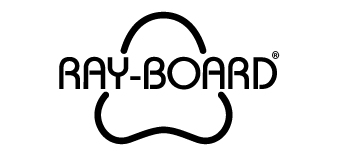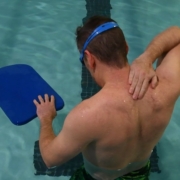10 Great Reasons Not to Use a (Flat) Kickboard
What others are saying about kickboards
I just read a great article on swimscience.net subtitled “Ten Reasons Swimmers Should Never Use a Kickboard”. It’s a thoughtful list and I encourage you to read the article, but I disagree that the solution is to abandon all kickboards. Let’s just get rid of the old, cheap flat ones. After reading through the list you’ll find that the unique shape of Ray-Board™ directly addresses most of the author’s kickboard concerns. The list can be divided into three basic problems:
A (flat) kickboard leads to shoulder, back and neck injuries
To maximize buoyancy, most swimmers use a kickboard with their arms fully extended. This increases shoulder stress and can lead to injury. At a minimum, it is very uncomfortable to stay in this extended position lap after lap. Flat kickboards also force the swimmers head out of the water. This may provide lots of opportunities to catch your breath, but it also stresses the neck muscles, which can lead to sharp pain. Further, to achieve the raised head position you must overly extend your back. In time this can lead to lower back pain or muscular compensation that can transfer to the shoulders.

A (flat) kickboard takes swimmers out of a balanced body position, which can create bad habits
It is possible to obtain a good body position while using a flat kickboard, it just takes a lot of extra effort, is quite uncomfortable, and can increase the risk of injury. What happens more often is that swimmers don’t focus on their body position while kicking. Your legs drop, your back arches, your shoulders drop under your head. And when kick training do you really want to be focused on your arm position? Maintaining this bad body position is only going to create bad habits and cause problems when you’re swimming without a kickboard.
The leg mechanics of kicking with a (flat) kickboard are different from regular kicking
The point of doing kicking drills is to improve your kick, so the drills should achieve the same kicking motion as kicking without a kickboard. With flat kickboards, swimmers often use only their lower legs. They don’t use a full leg kick. Also, doing a dolphin kick with a flat kickboard is challenging because the board is difficult to control.
The Solution: Ray-Board™
The author’s many issues with flat kickboards are entirely overcome through the unique design of Ray-Board. By dropping your elbows deeper in the water and allowing a wider, bent-elbow arm position, Ray-Board puts your shoulders, neck and back in a position that you can maintain lap after lap. Your upper-body muscles actually get to relax during your kick session.
Ray-Board promotes a more natural swim position. This means your kicking drills with Ray-Board will reinforce good habits rather than bad ones. Lastly, the wide elbow position and support provided by Ray-Board provides a stable base against which the swimmer can generate a strong, full-leg kick. The shape and handle of Ray-Board also allow you to control it above and below the water, making it a great tool for dolphin kick training.




